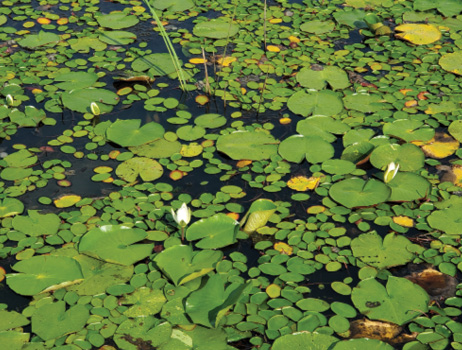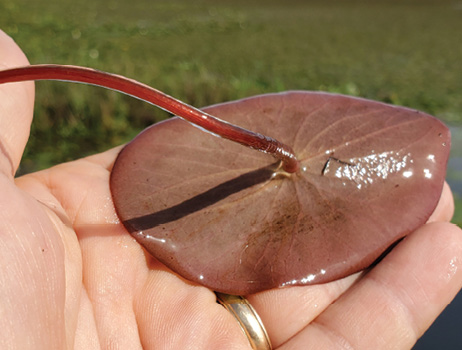Water Shield | Brasenia schreberi
Emergent | Native



Water shield, or dollar bonnet, is a floating-leaf plant. Its small, oval leaves are attached to long stalks that connect the plant to the roots on the pond bottom. Water shield leaves are smaller than similar species, never exceeding 4 inches long. The smooth, pale green leaves do not have a notch where the stalk attaches.
A key characteristic is the red to burgundy color of the stalks and undersides of floating leaves. The thick, gelatinous coating found on the undersides of the leaves can be up to one-fourth inch thick.
Flowers are very small and often overlooked. They are dull purple and usually about a half-inch or smaller in diameter. These blooms produce a leathery, club-shaped fruit that is smaller than the flower.
Water shield is rooted in the bottom soil, and the species can grow about 6 feet deep into a water body.
Management Value
Water shield is a native plant, and its seeds are eaten by waterfowl. The leaves and stalks provide habitat for fish. In small quantities it is part of a healthy pond ecosystem, although it is highly invasive and usually takes over all but the deepest ponds. Water shield is not recommended for pond management and should be controlled at first appearance.
Recommended Controls
Option 1: Flumioxazin (4.0-pound formulation). Flumioxazin (1.1 pints per acre-foot of water) should be applied as a submersed injection (application using a wand or hose). Determine pond volume prior to application. Use a buffering agent when mixing with water with pH greater than 7.0. Do not exceed annual herbicide rate limits as stated on the product label.
NOTE: Acre-foot = average depth of pond multiplied by pond acreage; average depth is calculated by taking the depth at 20 points across a water body and averaging the values.
Option 2: 2,4-D (3.8-pound formulation). For each gallon of water, mix 1.28 ounces 2,4-D and 1.3 ounces non-ionic surfactant. Spray to wet all plants. Do not exceed annual herbicide rate limits as stated on the product label.
The best approach is to treat ponds with herbicides when the water temperature is at least 60˚F and the plants are actively growing.
Treat one-third of the pond at a time, with a week or more separating applications. After the entire pond has been treated, a repeat whole-pond application may be needed to eliminate remaining plants. Following treatment, stock three to five triploid grass carp per acre to prevent re-infestation. Stock 8- to 10-inch triploid grass carp in ponds that have established largemouth bass populations to avoid predation by bass.
Read and follow all chemical label instructions, especially the section on the use of personal protection equipment.

The information given here is for educational purposes only. References to commercial products, trade names, or suppliers are made with the understanding that no endorsement is implied and that no discrimination against other products or suppliers is intended.
Publication 3735-38 (POD-11-23)
By Wes Neal, PhD, Extension/Research Professor, Wildlife, Fisheries, and Aquaculture; Dennis Riecke, Fisheries Coordinator, Mississippi Department of Wildlife, Fisheries, and Parks; and Gray Turnage, PhD, Assistant Research/Extension Professor, GeoSystems Research Institute.
The Mississippi State University Extension Service is working to ensure all web content is accessible to all users. If you need assistance accessing any of our content, please email the webteam or call 662-325-2262.



